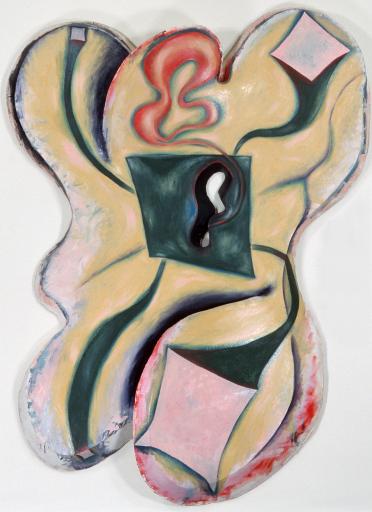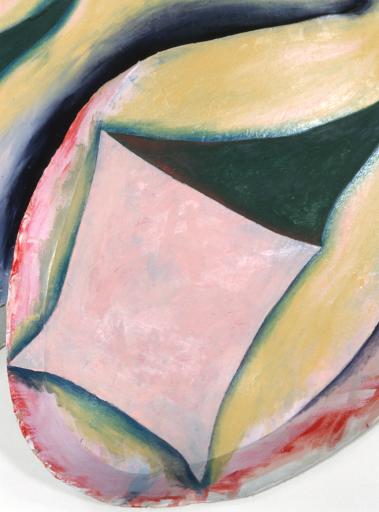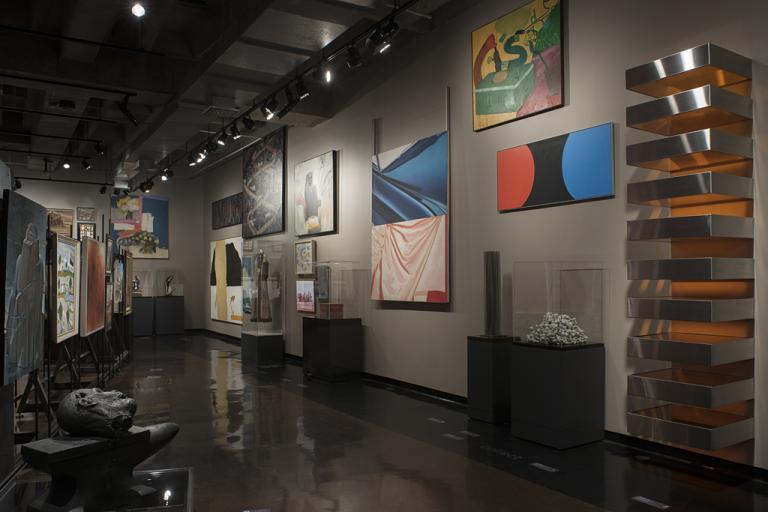Chaotic Lip, Elizabeth Murray
Artwork Overview
Object Length/Width/Depth (Length x Width x Depth): 298.5 x 219.7 x 30.5 cm
Object Length/Width/Depth (Length x Width x Depth): 86 1/2 x 117 1/2 x 12 in
If you wish to reproduce this image, please submit an image request
Images
Label texts
Is this artwork a painted sculpture or a sculpted painting? Elizabeth Murray curves and bends the shape of this large canvas and leaves staples, frayed edges, and unpainted areas exposed. Murray was fascinated with contradictions in art and often tried to challenge her own rules for creating. Does the power of this piece come from its striking large size, or does power emerge from its sensuous lines and forms?
Is this artwork a painted sculpture or a sculpted painting? Elizabeth Murray curves and bends the shape of this large canvas and leaves staples, frayed edges, and unpainted areas exposed. Murray was fascinated with contradictions in art and often tried to challenge her own rules for creating. Does the power of this piece come from its striking large size, or does power emerge from its sensuous lines and forms?
Elizabeth Murray experimented with painting for nearly three decades, beginning at a time when many American artists were questioning the traditional distinctions between painting and sculpture. Chaotic Lip shows Murray’s fascination with such contradictions. It may be difficult for the viewer to decide whether the piece is a painted sculpture or a sculpted painting.
Murray deliberately chooses muddy colors, an oddly shaped canvas, and a crudely half-painted style to present her strange, biomorphic images. She began her career studying illustration and cartooning. In this piece, an exaggerated pair of lips appears in the upper part and as a cut-out on a square in the center. Murray also tries to convey a sense of spontaneity by leaving staples, frayed edges, and unpainted areas of canvas exposed as if the work were unfinished.
Elizabeth Murray experimented with painting for nearly three decades, beginning at a time when many American artists were questioning the traditional distinctions between painting and sculpture. Chaotic Lip shows Murray’s fascination with such contradictions. It may be difficult for the viewer to decide whether the piece is a painted sculpture or a sculpted painting.
Murray deliberately chooses muddy colors, an oddly shaped canvas, and a crudely half-painted style to present her strange, biomorphic images. She began her career studying illustration and cartooning. In this piece, an exaggerated pair of lips appears in the upper part and as a cut-out on a square in the center. Murray also tries to convey a sense of spontaneity by leaving staples, frayed edges, and unpainted areas of canvas exposed as if the work were unfinished.
Elizabeth Murray has explored the formal expressive potentials of painting for nearly three decades, at a time when traditional distinctions between painting and sculpture were being questioned by American artists. Chaotic Lip shows Murray’s fascination with such contradictions. The work contains a tension between the spatial illusionism of painting and the three-dimensionality of relief sculpture, as it twists and pulls away form the wall. It may be difficult for the viewer to decide whether the piece is painted sculpture or a sculpted painting.
Murray’s art is not “pretty” or easy to like. She deliberately chooses muddy, raw colors, a tripped oddly distorted shaped canvas, and a crudely half-painted style to present her strange, biomorphic images, which seem to be derived from both dreams and comic books. Murray began her career studying commercial illustration and cartooning and cone can see this playful aspect in her work. She loves the way the exaggerated gestures of figures in cartoons zoom in and out of space, and she uses some of those effects in this piece. An exaggerated pair of lips appears in the upper part and as a cut-out on a square in the center of the work. Four similar squares rush outward in comic-book fashion on each of the four corners of the “painting.” Murray also tries to convey a sense of spontaneity and process - the chaos of creation - in this piece by leaving staples, frayed edges, and unpainted areas of canvas exposed as if the work were unfinished.
Elizabeth Murray has explored the formal expressive potentials of painting for nearly three decades, at a time when traditional distinctions between painting and sculpture were being questioned by American artists. Chaotic Lip shows Murray’s fascination with such contradictions. The work contains a tension between the spatial illusionism of painting and the three-dimensionality of relief sculpture, as it twists and pulls away form the wall. It may be difficult for the viewer to decide whether the piece is painted sculpture or a sculpted painting.
Murray’s art is not “pretty” or easy to like. She deliberately chooses muddy, raw colors, a tripped oddly distorted shaped canvas, and a crudely half-painted style to present her strange, biomorphic images, which seem to be derived from both dreams and comic books. Murray began her career studying commercial illustration and cartooning and cone can see this playful aspect in her work. She loves the way the exaggerated gestures of figures in cartoons zoom in and out of space, and she uses some of those effects in this piece. An exaggerated pair of lips appears in the upper part and as a cut-out on a square in the center of the work. Four similar squares rush outward in comic-book fashion on each of the four corners of the “painting.” Murray also tries to convey a sense of spontaneity and process - the chaos of creation - in this piece by leaving staples, frayed edges, and unpainted areas of canvas exposed as if the work were unfinished.
Didactic label content here.
Elizabeth Murray has explored the formal expressive potentials of painting for nearly three decades, at a time when traditional distinctions between painting and sculpture were being questioned by American artists. Chaotic Lip shows Murray’s fascination with such contradictions. The work contains a tension between the spatial illusionism of painting and the three-dimensionality of relief sculpture, as it twists and pulls away form the wall. It may be difficult for the viewer to decide whether the piece is painted sculpture or a sculpted painting.
Murray’s art is not “pretty” or easy to like. She deliberately chooses muddy, raw colors, a tripped oddly distorted shaped canvas, and a crudely half-painted style to present her strange, biomorphic images, which seem to be derived from both dreams and comic books. Murray began her career studying commercial illustration and cartooning and cone can see this playful aspect in her work. She loves the way the exaggerated gestures of figures in cartoons zoom in and out of space, and she uses some of those effects in this piece. An exaggerated pair of lips appears in the upper part and as a cut-out on a square in the center of the work. Four similar squares rush outward in comic-book fashion on each of the four corners of the “painting.” Murray also tries to convey a sense of spontaneity and process - the chaos of creation - in this piece by leaving staples, frayed edges, and unpainted areas of canvas exposed as if the work were unfinished.
Elizabeth Murray has explored the formal expressive potentials of painting for nearly three decades, at a time when traditional distinctions between painting and sculpture were being questioned by American artists. Chaotic Lip shows Murray’s fascination with such contradictions. The work contains a tension between the spatial illusionism of painting and the three-dimensionality of relief sculpture, as it twists and pulls away form the wall. It may be difficult for the viewer to decide whether the piece is painted sculpture or a sculpted painting.
Murray’s art is not “pretty” or easy to like. She deliberately chooses muddy, raw colors, a tripped oddly distorted shaped canvas, and a crudely half-painted style to present her strange, biomorphic images, which seem to be derived from both dreams and comic books. Murray began her career studying commercial illustration and cartooning and cone can see this playful aspect in her work. She loves the way the exaggerated gestures of figures in cartoons zoom in and out of space, and she uses some of those effects in this piece. An exaggerated pair of lips appears in the upper part and as a cut-out on a square in the center of the work. Four similar squares rush outward in comic-book fashion on each of the four corners of the “painting.” Murray also tries to convey a sense of spontaneity and process - the chaos of creation - in this piece by leaving staples, frayed edges, and unpainted areas of canvas exposed as if the work were unfinished.
Archive Label:
Elizabeth Murray has explored the formal expressive potentials of painting for nearly three decades, at a time when traditional distinctions between painting and sculpture were being questioned by American artists. Chaotic Lip shows Murray’s fascination with such contradictions. The work contains a tension between the spatial illusionism of painting and the three-dimensionality of relief sculpture, as it twists and pulls away form the wall. It may be difficult for the viewer to decide whether the piece is painted sculpture or a sculpted painting.
Murray’s art is not “pretty” or easy to like. She deliberately chooses muddy, raw colors, a tripped oddly distorted shaped canvas, and a crudely half-painted style to present her strange, biomorphic images, which seem to be derived from both dreams and comic books. Murray began her career studying commercial illustration and cartooning and cone can see this playful aspect in her work. She loves the way the exaggerated gestures of figures in cartoons zoom in and out of space, and she uses some of those effects in this piece. An exaggerated pair of lips appears in the upper part and as a cut-out on a square in the center of the work. Four similar squares rush outward in comic-book fashion on each of the four corners of the “painting.” Murray also tries to convey a sense of spontaneity and process - the chaos of creation - in this piece by leaving staples, frayed edges, and unpainted areas of canvas exposed as if the work were unfinished.
Exhibitions
Celka Straughn, curator
Kristina Walker, curator
Angela Watts, curator
Celka Straughn, curator
Kristina Walker, curator
Angela Watts, curator



















